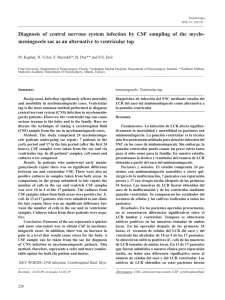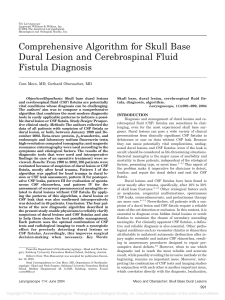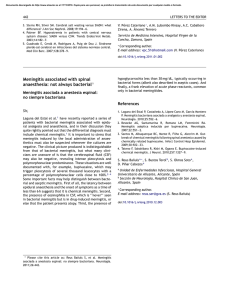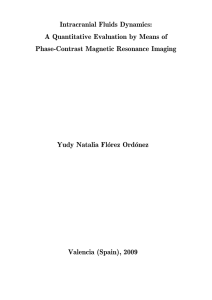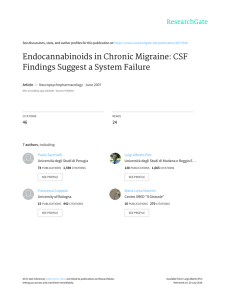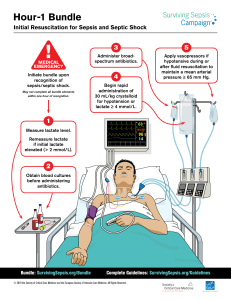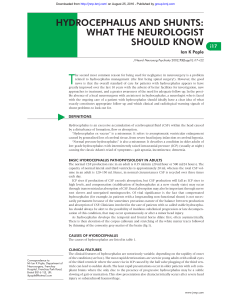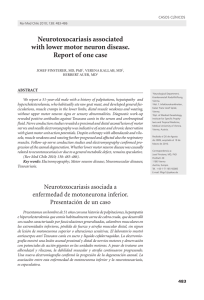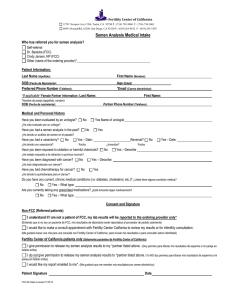CSF Stability: Cytological & Biochemical Parameter Assessment
Anuncio
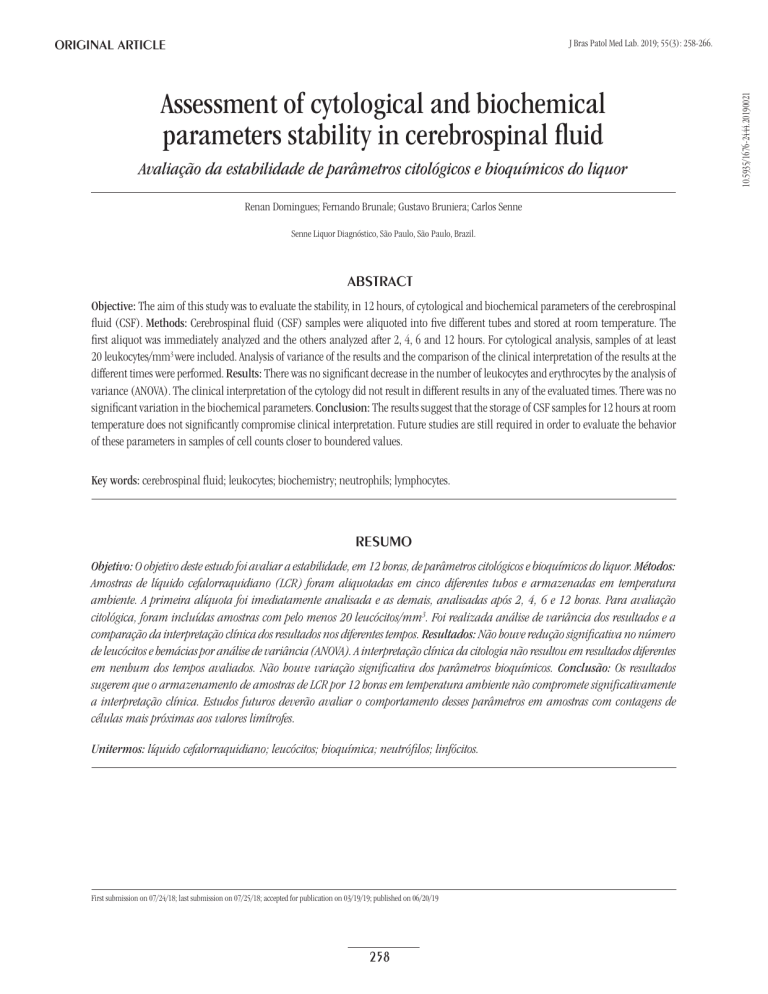
original article Assessment of cytological and biochemical parameters stability in cerebrospinal fluid Avaliação da estabilidade de parâmetros citológicos e bioquímicos do liquor Renan Domingues; Fernando Brunale; Gustavo Bruniera; Carlos Senne Senne Liquor Diagnóstico, São Paulo, São Paulo, Brazil. abstract Objective: The aim of this study was to evaluate the stability, in 12 hours, of cytological and biochemical parameters of the cerebrospinal fluid (CSF). Methods: Cerebrospinal fluid (CSF) samples were aliquoted into five different tubes and stored at room temperature. The first aliquot was immediately analyzed and the others analyzed after 2, 4, 6 and 12 hours. For cytological analysis, samples of at least 20 leukocytes/mm3 were included. Analysis of variance of the results and the comparison of the clinical interpretation of the results at the different times were performed. Results: There was no significant decrease in the number of leukocytes and erythrocytes by the analysis of variance (ANOVA). The clinical interpretation of the cytology did not result in different results in any of the evaluated times. There was no significant variation in the biochemical parameters. Conclusion: The results suggest that the storage of CSF samples for 12 hours at room temperature does not significantly compromise clinical interpretation. Future studies are still required in order to evaluate the behavior of these parameters in samples of cell counts closer to boundered values. Key words: cerebrospinal fluid; leukocytes; biochemistry; neutrophils; lymphocytes. resumo Objetivo: O objetivo deste estudo foi avaliar a estabilidade, em 12 horas, de parâmetros citológicos e bioquímicos do liquor. Métodos: Amostras de líquido cefalorraquidiano (LCR) foram aliquotadas em cinco diferentes tubos e armazenadas em temperatura ambiente. A primeira alíquota foi imediatamente analisada e as demais, analisadas após 2, 4, 6 e 12 horas. Para avaliação citológica, foram incluídas amostras com pelo menos 20 leucócitos/mm3. Foi realizada análise de variância dos resultados e a comparação da interpretação clínica dos resultados nos diferentes tempos. Resultados: Não houve redução significativa no número de leucócitos e hemácias por análise de variância (ANOVA). A interpretação clínica da citologia não resultou em resultados diferentes em nenhum dos tempos avaliados. Não houve variação significativa dos parâmetros bioquímicos. Conclusão: Os resultados sugerem que o armazenamento de amostras de LCR por 12 horas em temperatura ambiente não compromete significativamente a interpretação clínica. Estudos futuros deverão avaliar o comportamento desses parâmetros em amostras com contagens de células mais próximas aos valores limítrofes. Unitermos: líquido cefalorraquidiano; leucócitos; bioquímica; neutrófilos; linfócitos. First submission on 07/24/18; last submission on 07/25/18; accepted for publication on 03/19/19; published on 06/20/19 258 10.5935/1676-2444.20190021 J Bras Patol Med Lab. 2019; 55(3): 258-266. Assessment of cytological and biochemical parameters stability in cerebrospinal fluid resumen Objetivo: El objetivo de este estudio fue evaluar la estabilidad, en 12 horas, de parámetros citológicos y bioquímicos del líquido cefalorraquídeo (LCR). Métodos: Muestras del LCR fueron alicuotadas en cinco viales diferentes y almacenadas a temperatura ambiente. La primera alícuota fue inmediatamente analizada y las demás, analizadas tras 2, 4, 6 y 12 horas. Para la evaluación citológica, se incluyeron muestras con al menos 20 leucocitos/mm3. Se realizó el análisis de la varianza (ANOVA) de los resultados y la comparación de su interpretación clínica en los diferentes tiempos. Resultados: No hubo reducción significativa en el número de leucocitos y hematíes por ANOVA. La interpretación clínica de la citología no mostró resultados diferentes en ningún de los tiempos evaluados. No hubo variación significativa de los parámetros bioquímicos. Conclusión: Los resultados sugieren que el almacenamiento de muestras de LCR por 12 horas a temperatura ambiente no compromete significativamente la interpretación clínica. Nuevos ensayos deben evaluar el comportamiento de eses parámetros en muestras con recuentos de células más cercanas a los valores limítrofes. Palabras clave: líquido cefalorraquídeo; leucocitos; bioquímica; neutrófilos; linfocitos. Introduction Methods The cerebrospinal fluid (CSF) is a dynamic body fluid that is largely used in the diagnosis of many tumor or inflammatory, infectious, vascular and degenerative diseases(1). Several CSF parameters such as protein, glucose, lactate, white and red blood cells, among others, are routinely measured and their patterns may suggest the presence of a particular pathological process(2, 3). All CSF samples included in the present study were obtained for clinical purposes. Physicians for the Senne Liquor Diagnóstico performed the lumbar punctures. The time between CSF withdrawal and the initial analysis took up to 2 hours. The CSF samples were stored at 17°C room temperature during analyses. CSF is usually obtained by lumbar puncture (LP), collected into appropriated tubes. Following the collection of CSF the tubes are transported to the laboratory and the there is a variable period of time for CSF analysis. This period of time is determined by factors, such as the distance between the hospital and the analysis laboratory. It is also possible that samples are collected in locations where there is no specialized laboratory, and the samples need to be sent to a laboratory. Considering the period of time between CSF collection and CSF analysis, it is important to know the stability of the CSF components to understand how it affects the clinical interpretation of CSF results. White and red blood cells analyses It has been previously suggested that cytological examination should be performed within 2 hours after LP(4). This is based on expert opinion and also by experimental studies with inoculation of white blood cells into sterile CSF samples(5). However, these data do not necessarily reflect what happens to the clinical samples in the conditions that CSF is actually stored. Furthermore, very little is known about the stability of other CSF components, such as biochemical parameters(6). The aim of this study was to investigate the stability of CSF leukocytes, CSF red blood cells, CSF protein, CSF glucose, and CSF lactate over 12 hours. 259 Fifteen CSF samples collected from 15 patients submitted to LP by medical recommendation were used for white and red blood cells stability analysis. All these CSF samples were sent to the main unity of the Senne Liquor Diagnóstico Laboratory in accordance with Brazilian authorities regulations [Agência Nacional de Vigilância Sanitária (Anvisa), RDC 20/2014]. These samples were aliquoted into five different tubes that were analyzed at five different holding times: T0, T1 (2 hours), T2 (4 hours), T3 (6 hours), and T4 (12 hours). All the tubes were stored at room temperature. All these samples presented initially, at least, 20 leukocytes/mm3. Total leukocytes and red blood cells were counted in a Fuchs-Rosenthal counting-chamber and the differential cell count was performed after sedimentation and staining(7). Samples of less than 100 leukocytes/mm3 were centrifuged at 1000 rpm for 5 minutes. The same procedure was carried out in all five aliquots. We analyzed the variance of total leukocytes, neutrophils, lymphocytes, and red blood cells count, as well as neutrophil-to-lymphocyte ratio. The CSF pleocytosis was classified as mild (20-50 cell/mm3), moderate (50-200/ mm3) or marked (> 200/ mm3). The pattern of pleocytosis as well as polymorphonuclear (PMN) or lymphomononuclear (LMN) Renan Domingues; Fernando Brunale; Gustavo Bruniera; Carlos Senne predominance was registered and a comparison between the five period of time of each CSF sample was performed. Glucose, protein, and lactate analyses For biochemical analysis of stability we evaluated 20 CSF samples collected from 20 patients submitted to LP by medical recommendation. These CSF samples were sent to the main unity of Senne Liquor Diagnóstico Laboratory in accordance with RDC 20/2014 of Anvisa. Glucose, protein, and lactate concentrations were determined by colorimety. All the CSF samples were aliquoted into five different tubes. Each of these aliquots was analyzed at five different period of time: T0, T2-2 hours, T3-3 hours, T4-4 hours, T12-12 hours. Statistical analysis The analysis of variance of total leukocytes, neutrophils, lymphocytes, neutrophil-to-lymphocyte ratio, and red blood cells, glucose, protein, and lactate concentrations in the different period of time was performed with one-way analysis of variance (ANOVA). Tukey’s multiple comparison test was used to determine which means amongst them differ from the rest. The level of significance was set at p < 0.05. GraphPad Prism 5.0 software (GraphPad Software, San Diego, CA, USA) was used for all statistical analyses. Glucose, protein, and lactate The mean values of glucose, protein, and lactate are presented in Table 3. No significant variation was found with ANOVA for any of these variables. Tukey’s multiple comparison test showed no significant differences between glucose, protein, and lactate means for T0, T1, T2, T3, and T4. Table 1 − CSF findings in samples used for cytological stability assessment CSF Leukocytes Neutrophils Lymphocytes Protein (mm3) (%) (%) (mg/dl) 1 200 79 12 214 2 20 35 18 108 3 178 55 38 36 4 35 55 28 380 5 4800 78 10 7400 6 25 0 95 89 7 110 13 75 184 8 20 2 78 33 9 699 0 77 47 10 290 1 93 107 11 550 32 58 60 12 133 60 33 57 13 20 31 52 39 14 44 64 34 56 15 21 2 96 53 Glucose (mg/dl) 32 48 50 37 37 56 19 49 53 32 51 55 40 44 41 Lactate (mg/dl) 49.7 29.1 14.9 61.8 61.8 14.4 29 13.5 15.2 23.5 41.2 34.2 23.8 28.6 21.7 CSF: cerebrospinal fluid. Table 2 − Total leukocytes, lymphocytes, neutrophils, red cells counts, and neutrophils/lymphocytes ratios in the five different analyses times Results 0 2h 4h 6h 12 h (mean ± SD) (mean ± SD) (mean ± SD) (mean ± SD) (mean ± SD) White and red blood cells CSF findings of this group are shown in Table 1. The mean total of leukocytes, neutrophils, lymphocytes, neutrophil-tolymphocyte ratio, and red blood cells values are presented in Table 2. No significant variance was found for total leukocytes (p = 0.15), neutrophils (p = 0.27), lymphocytes (p = 0.15), neutrophil-to-lymphocyte ratio (p = 0.11), and red blood cells (p = 0.39). Tukey’s multiple comparison test showed no significant differences between T0, T1, T2, T3, and T4 for any of these variables. At T0 four CSFs presented mild pleocytosis with LMN predominance, three presented mild pleocytosis with PMN predominance, one presented moderate pleocytosis with LMN predominance, three presented moderate pleocytosis with PMN predominance, three presented marked pleocytosis with LMN predominance and one presented marked pleocytosis with PMN predominance. The pleocytosis pattern and the cell type predominance remained unchanged in T1, T2, T3, and T4 for all CSF samples. 260 Total leukocytes (mm3) Neutrophils (mm3) Lymphocytes (mm3) p 476 ± 1214 447 ± 1138 439 ± 1115 416 ± 1037 379 ± 936 0.15 288 ± 958 261 ± 863 261 ± 869 250 ± 828 223 ± 738 0.27 128 ± 182 129 ± 191 125 ± 183 125 ± 185 117 ± 172 0.15 Neutrophils/ lymphocytes 1.908 ± 2.826 2.022 ± 2.884 2.110 ± 3.130 2.021 ± 2.927 2.436 ± 3.888 0.11 ratio Red cells (mm3) 12110 ± 48425 10894 ± 43585 9130 ± 36310 8486 ± 33896 6098 ± 24204 0.39 SD: standard deviation. Table 3 − Mean protein, lactate, and glucose in the five different analyses times 0 2h 4h 6h 12 h p (mean ± SD) (mean ± SD) (mean ± SD) (mean ± SD) (mean ± SD) Protein 34.55 ± 12.1 34.7 ± 13.05 34.55 ± 12.16 34.85 ± 12.9 34.5 ± 12.29 0.9 (mg/dl) Lactate 14.45 ± 3.03 14.35 ± 3.03 14.4 ± 2.93 14.65 ± 3.04 14.35 ± 2.92 0.08 (mg/dl) Glucose 60.8 ± 14.71 60.85 ± 15.01 60.85 ± 14.98 60.90 ± 14.75 61.4 ± 14.66 0.11 (mg/dl) SD: standard deviation. Assessment of cytological and biochemical parameters stability in cerebrospinal fluid Discussion We did not find a statistical significant decrease in leukocytes and red blood cells count by variance analysis over 12 hours in CSF samples stored at room temperature. Furthermore, none of the cytological analyses resulted in different clinical interpretations over 12 hours of CSF storage at room temperature. To the best of our knowledge no previous study has evaluated the cytological variation over 12 hours in CSF samples stored at room temperature. A Class IV recommendation for cytological evaluation within two hours has been given because of potential lysis in white and red blood cells(4, 8). Previous experimental data showed significant decrease in neutrophils after one hour and in lymphocytes after three hours(5). Our findings suggest that the decrease in leukocytes count does not significantly affect clinical interpretation of CSF samples of at least 20 leukocytes/mm3 stored at room temperature. In clinical practice it is often difficult to perform CSF analyses shortly after the CSF collection. Many hospitals and clinics do not have CSF service and need to submit the CSF samples. Our results suggest that this may not significantly interfere with the final result of CSF analysis. We found no significant variation in glucose, protein and lactate results within twelve hours. This subject was previously studied. One study assessed CSF glucose and lactate stability(9). They found that References 1. Jerrard DA, Hanna JR, Schindelheim GL. Cerebrospinal fluid. J Emerg Med. 2001; 21(2): 171-8. PubMed PMID: 11489408. 2. Seehusen DA, Reeves MM, Fomin DA. Cerebrospinal fluid analysis. Am Fam Physician. 2003; 68(6): 1103-8. PubMed PMID: 14524396. 3. Huy NT, Thao NT, Diep DT, Kikuchi M, Zamora J, Hirayama K. Cerebrospinal fluid lactate concentration to distinguish bacterial from aseptic meningitis: a systemic review and meta-analysis. Crit Care. 2010; 14(6): R240. PubMed PMID: 21194480; PubMed Central PMCID: PMC3220013. 4. Deisenhammer F, Bartos A, Egg R, et al.; EFNS Task Force. Guidelines on routine cerebrospinal fluid analysis. Report from an EFNS task force. Eur J Neurol. 2006; 13(9): 913-22. PubMed PMID: 16930354. 5. Steele RW, Marmer DJ, O’Brien MD, Tyson ST, Steele CR. Leukocyte survival in cerebrospinal fluid. J Clin Microbiol. 1986; 23(5): 965-6. PubMed PMID: 3711287. these parameters were stable in CSF samples stored over 24 hours, both in samples with normal or high levels of CSF cell count(6). Other study showed that CSF lactate was stable over three days at room temperature(10). Therefore, our data are in line with previous studies of glucose and lactate CSF stability. Protein concentration was also stable in our study; however, we only evaluated total protein concentration. Further research is needed to evaluate the stability of specific proteins like albumin and immunoglobulin. The limitations of the present study include the small sample size. In addition, we only analyzed CSF samples of at least 20 leukocytes/mm3 at initial evaluation. it is not possible to speculate about cytological variance and clinical interpretation in samples of less than 20 leukocytes/mm3 with our data, and further studies in this direction are still required. Furthermore, the present work assessed the effect of CSF storage only at room temperature. The laboratory, in which this study was carried out, such as most of the services, recommends CSF analysis as soon as CSF is received and storage at 4°C. It is still necessary to assess the effect of temperature on CSF parameters stability. In conclusion, we showed that CSF parameters remain relatively stable, not significantly affecting clinical interpretation in the first 12 hours of storage at room temperature, suggesting that CSF samples can be safely submitted to a CSF specialized service within this period of time. 6. Dujmovic I, Deisenhammer F. Stability of cerebrospinal fluid/serum glucose ratio and cerebrospinal fluid lactate concentrations over 24 h: analysis of repeated measurements. Clin Chem Lab Med. 2010; 48(2): 209-12. PubMed PMID: 19958211. 7. Anguiano GL, Ancira GV. Direct simultaneous total and differential leukocyte counts in the counting chamber. Acta Haematol. 1955; 13(2): 124-7. PubMed PMID: 14361097. 8. UK National External Quality Assessment Scheme for Immunochemistry Working Group. National guidelines for analysis of cerebrospinal fluid for bilirubin in suspected subarachnoid haemorrhage. Ann Clin Biochem. 2003; 40(Pt 5): 481-8. PubMed PMID: 14503985. 9. Levine J, Panchalingam K, McClure RJ, Gershon S, Pettegrew JW. Stability of CSF metabolites measured by proton NMR. J Neural Transm (Vienna). 2000; 107(7): 843-8. PubMed PMID: 11005549. 10. Zhang L, Gabler J, Payto D, Wang S. Stability of lactate and pyruvate in cerebrospinal fluid under typical clinical laboratory storage conditions. Clin Biochem 2015; 48(9): 631-2. PubMed PMID: 25863113. Corresponding author Renan Domingues 0000-0002-6058-7937 e-mail: [email protected] This is an open-access article distributed under the terms of the Creative Commons Attribution License. 261
